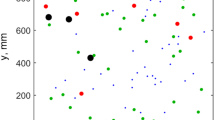Abstract
Attempts are presented of an analogue modelling of Daphnia responses to various influences and stimuli, as distribution of food and of predators. An aim of the study is to examine to what extent a statistical-mechanical approach may be useful as a tool in modelling of Daphnia swarms behaviour. In the modelling we follow a line close to test particle studies in physical sciences. A generalized kinetic equation of what we shall call daphnicles is derived. The modelling incorporates individual characteristics of daphnicles, as position, velocity, degree of food saturation and responses daphnicles have to outside influences. Each daphnicle we assume responds to some stimuli in ordered ways and to others in stochastic ways, and the degree or strength of reactions depends on the density of all daphnicles, the density of food available, the saturation level of daphnicles and the threat level in the environment, or background, the daphnicles are living on. Some fluid equations of daphnicle swarms are subsequently derived from the basic equation, and solutions are given of the model-equations, including a food distribution equation, in some particular cases that show peculiarities in reactions of daphnicles to food, degree of saturation and to threat, when these are acting alone, and in combination. The modelling results may be compared to results of laboratory experiments of Daphnia behaviour that soon will be performed.
Similar content being viewed by others
References
Chapman, S. and T. G. Cowling (1939). The Mathematical Theory of Non-Uniform Gases, London: Cambridge University Press.
Flierl, G., D. Grünbaum, S. Levin and D. Olson (1999). From individuals to aggregations: the interplay between behavior and physics. J. Theor. Biol. 196, 397–454.
Freund, J. A., L. Schimansky-Geier, B. Beisner, A. Neiman, D. F. Russell, T. Yakusheva and F. Moss (2002). Behavioral stochastic resonance: how the noise from a Daphnia swarm enhances individual prey capture by juvenile paddlefish. J. Theor. Biol. 214, 71–83.
Grünbaum, D. (2000). Advection-diffusion equations for internal state-mediated random walks. SIAM J. Appl. Math. 61, 43–73.
Hamilton, W. D. (1971). Geometry for the selfish herd. J. Theor. Biol. 31, 295–311.
Jakobsen, P. J. and G. H. Johnsen (1987). Behavioural response of the water flea Daphnia pulex to a gradient in food concentration. Anim. Behav. 35, 1891–1895.
Jensen, K. H. M. (2000). Gregariousness in Daphnia: significance of food distribution and predator evasion. Dr. science thesis, Department of Zoology, University of Bergen, Norway.
Kleiven, O. T., P. Larsson and A. Hobæk (1996). Direct distributional response in Daphnia pulex to a predatorkairomone. J. Plankton Res. 18, 1341–1348.
Larsson, P. (1997). Ideal free distribution in Daphnia? Are daphnids able to consider both the food patch quality and the position of competitors? Hydrobiologia 360, 143–152.
Larsson, P. and O. T. Kleiven (1995). Food search and swimming speed in Daphnia, in Zooplankton: Sensory Ecology and Physiology, P. H. Lenz, D. K. Hartline, J. E. Purcell and D. L. Macmillan (Eds), Amsterdam: Gordon and Breach Publishers, pp. 375–387.
Levin, S. A. and L. A. Segel (1985). Pattern generation in space and aspect. SIAM Rev. 27, 45–67.
Lin, C. C. and L. A. Segel (1974). Mathematics Applied to Deterministic Problems in the Natural Sciences, New York: Macmillan Publishing Co., Inc.
Montgomery, D. C. and D. A. Tidman (1964). Plasma Kinetic Theory, New York: McGraw-Hill.
Øien, A. H. (1999). Transition from collision-dominated to collisionless regions in a plasma: a global distribution function for outflowing light ions in polar regions of the ionosphere—an analytical approach. J. Plasma Phys. 61, 735–760.
Turner, G. F. and T. J. Pitcher (1986). Attack abatement: a model for group protection by combined avoidance and dilution. Am. Nat. 128, 228–240.
Author information
Authors and Affiliations
Rights and permissions
About this article
Cite this article
Øien, A.H. Daphnicle dynamics based on kinetic theory: An analogue-modelling of swarming and behaviour of Daphnia. Bull. Math. Biol. 66, 1–46 (2004). https://doi.org/10.1016/S0092-8240(03)00065-X
Received:
Accepted:
Issue Date:
DOI: https://doi.org/10.1016/S0092-8240(03)00065-X




